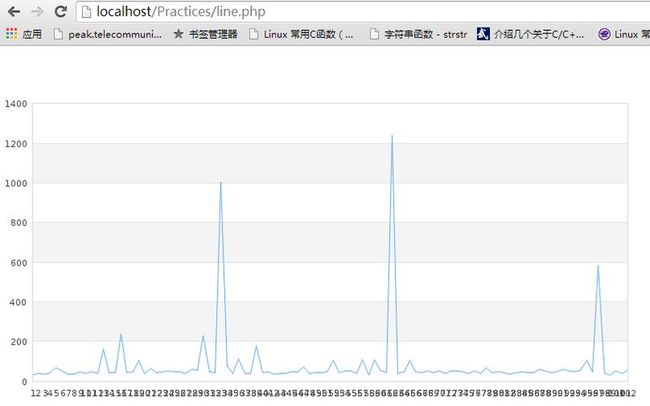最小性能测试(监控)系统
STEP1: http_load压测 (http_load的使用方法略)
如:http_load.exe -fetches 500 -parallel 50 urls.txt
STEP2: 压测结果入数据库
CREATE TABLE `t_p50f50qqcom` ( `id` int(11) NOT NULL AUTO_INCREMENT, `time` datetime NOT NULL, `mean` float NOT NULL, `max` float NOT NULL, `min` float NOT NULL, PRIMARY KEY (`id`) ) ENGINE=InnoDB AUTO_INCREMENT=104 DEFAULT CHARSET=utf8 COLLATE=utf8_bin; -- ---------------------------- -- Table structure for t_table_perporty -- ---------------------------- CREATE TABLE `t_table_perporty` ( `f_tid` int(11) NOT NULL, `f_status` tinyint(3) unsigned zerofill NOT NULL DEFAULT '000' COMMENT '0:valid 1:....', `f_table_name` varchar(64) COLLATE utf8_bin NOT NULL, `f_value_unit` varchar(16) COLLATE utf8_bin DEFAULT NULL, `f_table_note` varchar(128) COLLATE utf8_bin DEFAULT NULL, PRIMARY KEY (`f_tid`) ) ENGINE=InnoDB DEFAULT CHARSET=utf8 COLLATE=utf8_bin;
以下代码获取一轮压测数据并提取出来每个请求平均时间,最大和最小时间并入库
#! D:\Python26\python.exe
# -*- coding:utf8 -*-
import os
import re
import sys
import time
import datetime
import subprocess
#http_load -p 100 -s 10
strTableName = "t_QQ_Req2Resp"
def dumpValue2Sql(dInput):
print dInput
strTableName = dInput["table"]
del dInput["table"]
strSql = "INSERT INTO %s (%s,%s,%s,%s) VALUES('%s',%f,%f,%f); " % (strTableName,"time","max","min","mean",\
dInput["time"],dInput["max"],dInput["min"],dInput["mean"])
print strSql
os.system('''mysql.exe -uroot perftest -s -e "%s"''' % strSql)
def resolveHttpRet(strRet):
'''
50 fetches, 50 max parallel, 2.74322e+07 bytes, in 26.7117 seconds
548643 mean bytes/connection
1.87184 fetches/sec, 1.02697e+06 bytes/sec
msecs/connect: 46.123 mean, 82.005 max, 9.001 min
msecs/first-response: 129.828 mean, 3047.2 max, 14.001 min
HTTP response codes:
code 200 -- 50
'''
lRet = strRet.strip().replace(",", "").split("\n")[3].split()
dRet = {lRet[2]:float(lRet[1]), lRet[4]:float(lRet[3]), lRet[6]:float(lRet[5])}
dRet["table"] = "t_p50f50qqcom"
dRet["time"] = datetime.datetime.now().strftime("%Y-%m-%d %H:%M:%S")
return dRet
def doReq(dParam):
strCommand = "http_load.exe "
if dParam["rate"] != 0: strCommand += " -rate %d " % dParam["rate"]
if dParam["fetches"] != 0: strCommand += " -fetches %d " % dParam["fetches"]
if dParam["seconds"] != 0: strCommand += " -seconds %d " % dParam["seconds"]
if dParam["parallel"] != 0: strCommand += " -parallel %d " % dParam["parallel"]
strCommand += " urls.txt"
print strCommand
oP = subprocess.Popen(strCommand, stdin = subprocess.PIPE, stdout = subprocess.PIPE, stderr = subprocess.PIPE)
strRet = oP.stdout.read()
return resolveHttpRet(strRet)
if __name__ == "__main__":
print "This is test web http by http_load, with mysql and python"
#strCommand = "http_load -p 5 -f 1000 urls.txt"
#os.system(strCommand)
dParam = {"parallel":50, "fetches":50, "rate":0, "seconds":0, "table":"t_p50f50qqcom"}
dRet = doReq(dParam)
dumpValue2Sql(dRet)
for i in range(0,100):
dRet = doReq(dParam)
dumpValue2Sql(dRet)
time.sleep(20)
STEP3: php展现
<?php //content="text/plain; charset=utf-8"
require_once ('src/jpgraph.php');
require_once ('src/jpgraph_line.php');
$hostname = "localhost";
$user = "perftest";
$password = "perftest";
mysql_connect($hostname, $user, $password) or die ("Database Failed");
mysql_select_db('perftest') or die("Database Error");
$sql = "select * from t_p50f50qqcom where time like '2014-05-03 %'";
$result = mysql_query($sql) or die("Select Error");
//输入的数据
$ydata = array();
while($row = mysql_fetch_row($result))
{
array_push($ydata, $row[2]);
}
mysql_free_result($result);
//创建图形
$graph = new Graph(800,500);
$graph->SetScale('textlin');
//创建折线图
$lineplot=new LinePlot($ydata);
$lineplot->SetColor('blue');
//在图上创建测量点
$graph->Add($lineplot);
//显示图形
$graph->Stroke();
mysql_close();
?>
效果:(如下图波动较大,是因为每轮测试时间只有50秒,可尝试加长时间,并在展现前清理一些异常数据)
